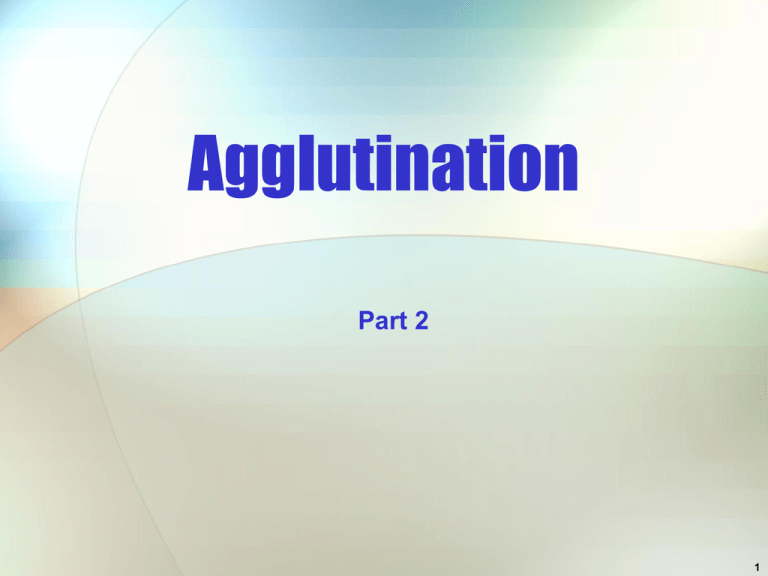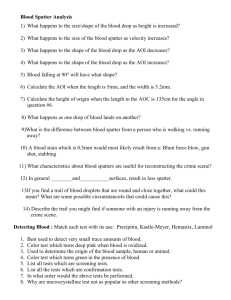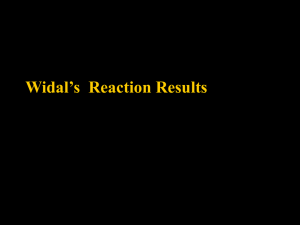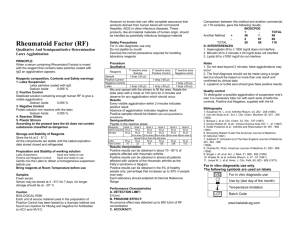Agglutination 2
advertisement

Agglutination Part 2 1 Latex agglutination • In latex agglutination procedures, Ag molecules can be bound to the surface of latex beads. • If Ab is present in the test specimen, the Ag will combine with the Ab and form visible aggregates. 2 Latex agglutination • Latex particles can be coated with Ab, and in the presence of Ag can form visible aggregates. 3 Reverse Indirect agglutination • Involves the adherence of Ab to inert particles which can then be used to detect the presence of Ag. • Example – latex particle coated with Ab (known) + serum looking for (unknown) Ag. If Ag present, then you get visible agglutination. 4 Reverse Indirect agglutination • Numerous kits are available for rapid identification of antigens on infectious agents • Examples: • Staphylococcus aureus • Neisseria maningetidis • Mycoplasma pneumoniae • Such tests used for organisms that • are difficult to grow • or when rapid identification is required 5 Reverse Indirect agglutination • Used also to measure • levels of therapeutic drugs, • hormones, • plasma proteins 6 Hemagglutination • The agglutination of red blood cells by either • direct agglutination • or indirect agglutination • Direct agg. Ag is an intrinsic component of RBC • Indirect agg. Soluble Ags are adsorbed to the RBC 7 Hemagglutination • There are 3 ways in which Ags may be bound to RBCs: 1. Spontaneous adsorption of Ags by RBCs 2. Covalent binding using chemical links 3. Tannic acid treatment 8 Hemagglutination • Qualitative agglutination test – Ag or Ab + ↔ 9 Hemagglutination • Quantitative agglutination test Neg. Pos. 1/1024 1/512 1/256 1/128 1/64 1/32 1/16 1/8 1/4 Patient 1/2 • Titer • Prozone Titer 1 2 3 64 8 512 4 5 <2 32 6 7 8 128 32 4 10 Indirect Hemagglutination • Definition - agglutination test done with a soluble antigen coated onto a particle + + ↔ 11 Agglutination inhibition / Hemagglutination inhibition • Involves interference by Ag or Ab with an Ag-Ab reaction which would have resulted in agglutination, if interference had not occurred. The technique is called hemagglutination inhibition if the particle in the reaction is a rbc. 12 Agglutination inhibition - pos • Tube containing Ab (known) • Patient has Ag (unknown) and combines with Ab. Not visible. • Latex bead coated with known Ag is added. It has nothing to attach to – no visible reaction or agglutination inhibition is positive. 13 Agglutination inhibition - neg • Tube containing Ab (known). • Patient serum does not contain Ag (unknown), therefore no combination. • Latex bead coated with known Ag directed to known Ab coated to tube. Visible agglutination, therefore agglutination inhibition is negative 14 Agglutination inhibition 15 Hemagglutination Inhibition • Definition - test based on the inhibition of agglutination due to competition with a soluble Ag + + ↔ Test Patient’s sample 16 Coagglutination • Coagglutination (CoA) is similar to the Latex Agglutination technique for detecting antigen • Protein A, a uniformly distributed cell wall component of Staphylococcus aureus, is able to bind to the Fc region of most IgG isotype antibodies leaving the Fab region free to interact with antigens present in the applied specimens. • The visible agglutination of the S. aureus particles indicates the antigen-antibody reaction. 17 Coagglutination 18 Coagglutination • These particles exhibit greater stability than Latex particles • However, bacteria are not colored & therefore reactions are often difficult to read. • Such tests are highly specific, but the sensitivity is less than latex particles method 19 Viral Hemagglutination • Many viruses have nonserological hemagglutinating properties • ِThey can agglutinate RBCs in the absence of Ab (nonimmune agglutination) 20 Viral Hemagglutination • Hemagglutination (HA) can be used to determine titers of certain viruses. • Mammalian reoviruses agglutinate erythrocytes through interactions between the viral surface protein sigma 1 and carbohydrate groups attached to proteins on erythrocyte membranes. • Visually, this interaction creates a shield of erythrocytes in a round-bottom 96 well plate (well F1). • In the absence of virus, the erythrocytes form a button in the well (well F12). 21 Viral Hemagglutination 22 Slide indirect Hemagglutination test Exercise 4 23 Principle • The Waaler-Rose (WR) reagent is a suspension of stabilized sheep red cells sensitized with anti-sheep rabbit IgG. • The WR test reagent sensivity has been adjusted to detect a minimum of 6 IU/mL of rheumatoid factors according with the WHO International Standard without previous sample dilution. 24 Sample • Use fresh serum obtained by centrifugation of clotted blood. • The sample may be stored at +2 oC to +8 oC for 48 hours before performing the test. • For longer periods of time the serum must be frozen. Hemolytic, lipemic or contaminated sera must be discarded 25 Reagents • Waaler Rose: Suspension of solubilized sheep erythrocytes sensitized with rabbit IgG anti-sheep erythrocytes • Positive Control • Negative Control 26 Preparation of reagents • Shake the Reagent 1 (red cells) before use. After that it must be uniform and without visible clumping. The sensitivity of the test depends of the drop volume (50 μl). Do not use droppers than those provided and hold the dropper perpendicular to the slide surface. • The reagent and controls have to be stored at +2 oC to +8 oC. Do not freeze. In these conditions the components will remain stable until the expiry date printed on the label. 27 Procedure • Before using the kit, allow the components to reach room temperature. • Gently shake the reagent to disperse the particles. Check the reagent against the positive and negative controls in the same way as the undiluted serum. 28 1. Qualitative Determination • Serum 1 drop (50 μl) + Reagent 1 drop • Place a drop of UNDILUTED serum onto a circle of the slide. • Add a drop of the Reagent 1 (red cells) next to the drop of serum. • Mix both drops spreading them over the full surface of the circle. • Let the slide to stay on a flat surface for two minutes. • After this time twist the slide 45 degrees once and let again to stay for one minute. • Read the presence or absence of visible agglutination in this period of time. • Unespecific agglutination could appear if the test is read later than this time. 29 Interpretation of Results • Examine macroscopically the presence3 or absence of visible agglutination immediately avoiding any movement or lifting of the slide during the observation. • The presence of agglutination indicates a content of RF in the sample equal or greater than 8 IU/ml. • The lack of agglutination indicates a RF level lower than 8 IU/ml in the sample 30 Semi-Quantitative method • This test is performed in the same way as the qualitative test but by using previous dilution of the serum sample in saline (NaCl 9 g/l), 31 Semi-Quantitative method 32 Calculations • The approximate RF concentration in the patient sample is calculated as follows: 8 X RF titer = IU/ml 33




